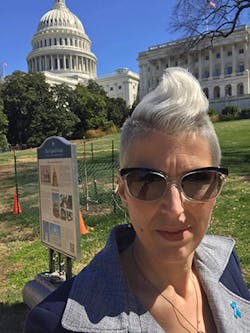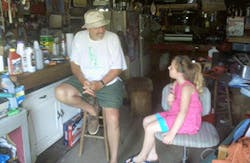“Was your dad a miner or did he work in construction of any kind?”
These are not the typical questions that you get from your doctor when you’ve just been diagnosed with cancer. But I was being asked those questions for a reason. I was 36 years old and found out I had a nefarious and rare cancer called mesothelioma, the cancer almost always caused by asbestos exposure.
I had never worked with asbestos myself, but yes, my dad had. See, he WAS a construction worker, and most of what he did in his first few years while learning the trade was drywall cleanup and demolition. Much of the drywall joint compound he worked with contained asbestos. Most of the buildings he worked in doing demolition contained asbestos tiles on the floor and in the ceiling. The insulation around pipes and boilers that he tore out was all asbestos insulation.
He would come home from work many days covered in dust, a thick, greyish-white crust covering his work jacket. A jacket I would wear to do my outside chores. A jacket I would put on to go out to the rabbit hutch in the back shed to feed and play with my rabbits. A jacket I would wear because it didn’t matter if it got dirty.
This jacket had asbestos dust all over it. His car had the same dust in it. The dust was just part of my childhood. This dust caused my illness. I thought asbestos had been banned years ago. I was shocked to learn this substance that knowingly causes a horrible cancer and so many health problems had indeed not been banned.
Here I was 36 years old, a new mom with a three-and-a-half-month-old baby at home, and I was being told I had probably 15 months to live if I didn’t do something drastic. My doctor laid out some options for me. The first was do nothing and maybe live 15 months, which was not an option with a new baby. The second option given was chemo and radiation, and hopefully make it 5 years.
The third option was an incredibly invasive surgery called an extrapleural pneumonectomy. This surgery entailed the removal of my entire left lung that was affected by the cancer, the lining of the lung, the left half of my diaphragm, the lining of my heart – both of which would be replaced with Gore-Tex – and then the removal of one or two ribs. This option afforded me the best prognosis: 7-10 years of survival, more if I was one of the lucky ones. Knowing now that mesothelioma usually kills its victims within the first 5 years, this option sounded like the best one to me.
The only drawback was that the most qualified and experienced surgeon was in Boston, some 1,400 miles away from our home in the Twin Cities of Minnesota. My husband didn’t bat an eye and said “Get us to Boston” before I could even process all that was happening to me.
I had so many questions and concerns. How were we going to pay for this? We were brand new parents. We used up a portion of our savings on my maternity leave. Who would take care of Lily while I had surgery? There was no way we could bring a new baby all the way to Boston while I had surgery and could hardly care for myself! Would we lose the house? The cars?
Most importantly, would I survive the surgery only to succumb to the cancer a few months later? Was the risk worth it?
I’m happy to say that everything worked out. I traveled to Boston and had the surgery, which saved my life. I followed it up with four sessions of chemo and 30 sessions of radiation to completely eradicate any remaining cells they couldn’t get with surgery. I celebrated 11 years since my surgery on Feb. 2, which marked officially one year beyond my best case scenario.
The More I Learned, the Angrier I Got
After my recovery from my surgery, chemo and radiation, I busied myself by learning more about mesothelioma and the deadly mineral that causes it. The more I learned, the angrier I got. Why was asbestos still legal and why was it still being used when so many other industrialized nations had banned it?
The sheer number of preventable deaths that happen every year because of our nation’s inability to ban a toxic substance enrages me. I decided to try and do something about it. I got involved with The Asbestos Disease Awareness Organization, began writing a blog for the Mesothelioma Cancer Alliance and started raising money for research for the Mesothelioma Applied Research Foundation.
I went to Capitol Hill and told my story to my representative, my senators. I want them to know what mesothelioma is, what it does to families and communities. I told them that because of asbestos, the first 18 months of my daughter’s life were a blur. I only have memories because of photos. Those are precious months I can never get back.
My exposure to asbestos has made me a different parent. We always have to live with the knowledge that the cancer could come back at any time. I live with a constant shadow over my shoulder, just out of view, but I know it’s there. My 11-year-old daughter knows that her mom could die at any time. No 11- year-old should carry that burden.
At the end of 2016, the EPA finally named asbestos as one of the top 10 chemicals that pose a health and environmental risk in recent toxic substance reform. It is the first step in getting a full ban on asbestos.
Our elation turned to despair upon the game-changing election in November, and subsequent appointment of Scott Pruitt to oversee the EPA. The very man chosen to run the EPA also sued the organization he is now in charge of no less than a dozen times, always on the side of industry and chemical companies.
Pruitt also has said that he remains unconvinced of the dangers of asbestos. I was livid when I heard that. It is a normal occurrence that at least two to three times a month, someone I know in the mesothelioma community dies after a period of horrible suffering. His statement is willful ignorance at best, much like his stance on climate change, pesticides and other chemicals.
To say I’m concerned about his appointment and the Trump administration’s proposed budget cuts to the EPA is an understatement. The EPA is the one agency in charge of superfund sites all over the United States, many of which are contaminated with asbestos and other deadly chemicals. The proposed cuts to the EPA would discontinue funding for programming research and diplomatic efforts related to climate change, more than 50 other EPA programs and cut around 3,200 of the 15,000 jobs at the agency.
In addition, the EPA dismissed several members of the Board of Scientific Counselors, an 18-member advisory board that reviews the research of EPA scientists. The reasoning behind this is they want to replace them with a diverse pool of applicants, including industry representatives. In a May 7th story by the New York Times, critics assailed the move, casting it as a gift to business interests at the expense of science.
As a victim of an environmental toxin, one that should be banned and is not regulated as steeply as it should be, this administration spells trouble for those of us fighting for the rights and lives of asbestos victims. A president who has extolled the virtues of asbestos and called the abatement of it a “mob conspiracy” spells trouble for the future of a complete ban on asbestos.
Why I Fight
Every week, I learn of a friend in the meso community struggling with a reoccurrence of their cancer. Some have options, many don’t. Mesothelioma is considered an orphan disease, and clinical trials are few and far between. Companies are hard pressed to invest the amount of money needed in development of new drugs and therapies to treat mesothelioma because it is so rare. I get nervous for my own future, knowing that.
On top of that, I learn of a new death from mesothelioma every week. Some people I’ve only known a short time, others longer. They all hurt. They all take their toll on me. It is why I continue to fight so hard for the victims of asbestos exposure, because they cannot. I will be the voice for the victim, for my family, for the families that have lost so much.
I would like to say that my own family escaped relatively unscathed from our asbestos exposure, but that wouldn’t be true. My own battle has taken its toll on my body. Losing my lung has caused my spine to curve, my shoulders to hunch and I live in constant pain. I’m able to keep it controlled fairly well, but some days are worse than others. I don’t have the stamina to play many sports with my daughter. I get winded and out of breath and have to stop to catch it.
My left arm and hand are numb and weak. They tell me it is damage from the combination of the surgery and extensive radiation I had. The entire left side of my body is frail and atrophied from the effects of the surgery and treatments. I have memory and concentration problems due to the chemo, affectionately called “chemo brain.”
My hearing is shot from the cisplatin, one of the chemo drugs. It gives people chronic tinnitus, so I have trouble hearing. I had to give up my career as a stylist and co-owner of a busy salon/spa, as I am not able to be around all the chemicals with one lung and I don’t have the stamina to stand behind the chair for 8 hours a day like I used to.
My dad, who worked with asbestos, was diagnosed with clear cell renal carcinoma. I’m not convinced his cancer wasn’t caused by his exposure to asbestos from all his years working construction. He passed away after a short, four-month battle on Feb. 27, one day after his 71st birthday.
I hope all my work and advocacy is making him proud. He told me once I was going to be a lighthouse for people, a beacon of hope in their stormy seas. He told me I was his lighthouse. I miss him every single minute of every single day.
People have asked me if I was ever mad at my dad because of the asbestos exposure. In no way do I hold my dad responsible for my illness. He was simply doing his job to keep a roof over our heads and food on our table. I hold responsible those companies that supplied the asbestos in the products that my dad worked with all those years without him knowing the dangers. Those companies knew their products made people sick and killed them. I hold our own government responsible for not banning asbestos and enacting stricter regulations on its use.
Like my friend Linda Reinstein from the Asbestos Disease Awareness Organization says, “Turn anger into action,” and I intend to keep doing just that.


